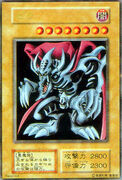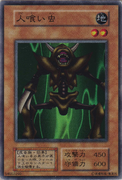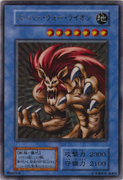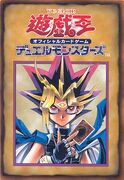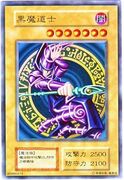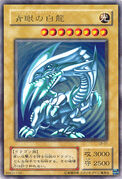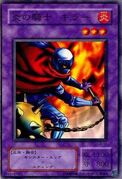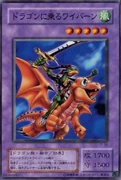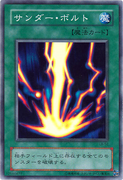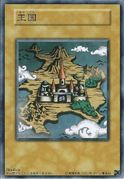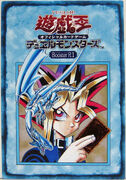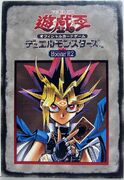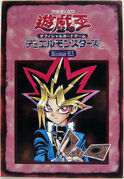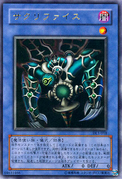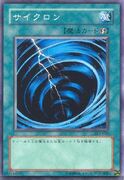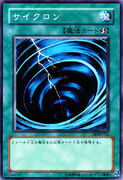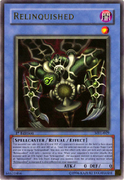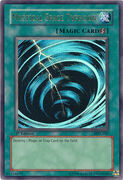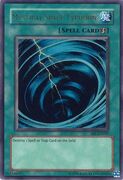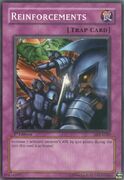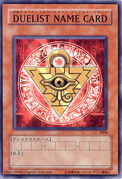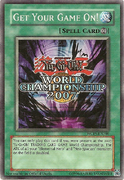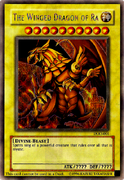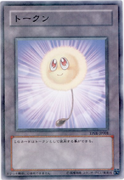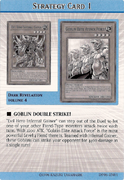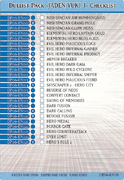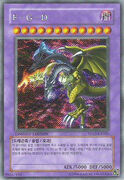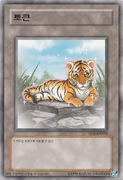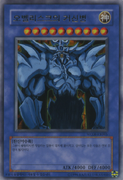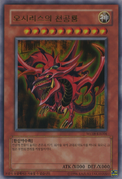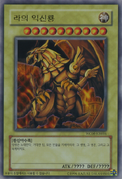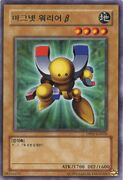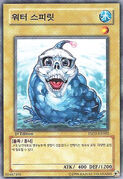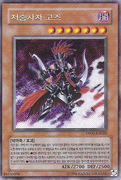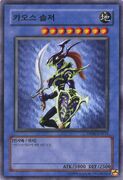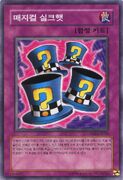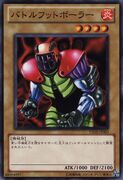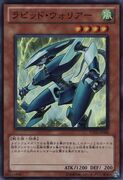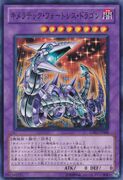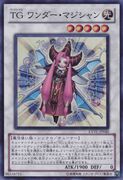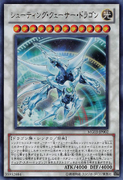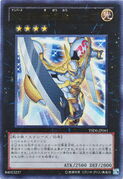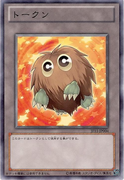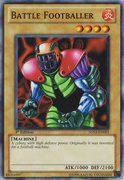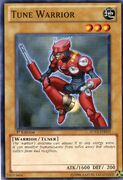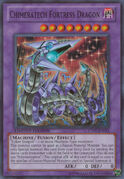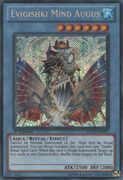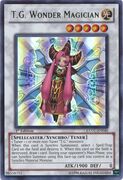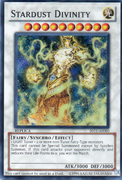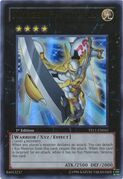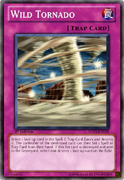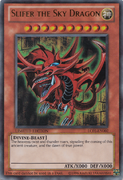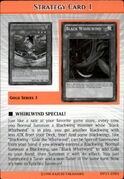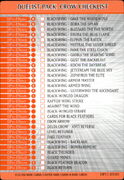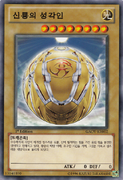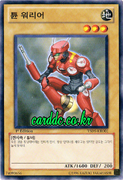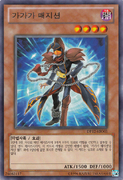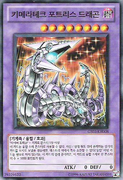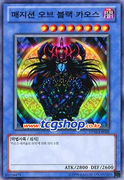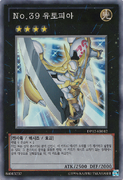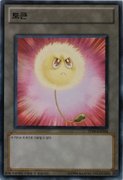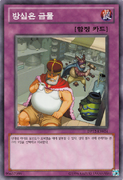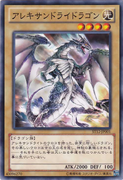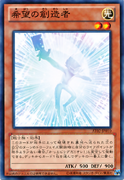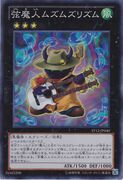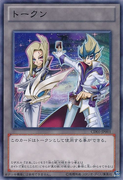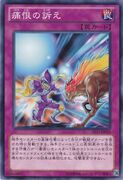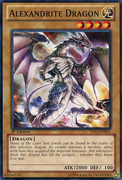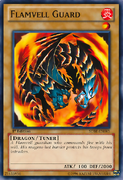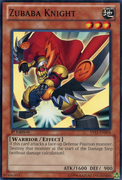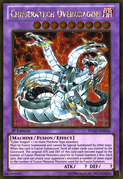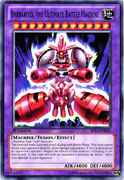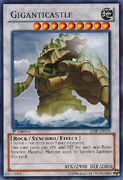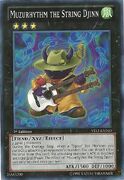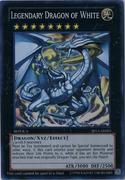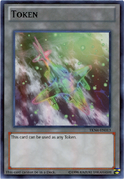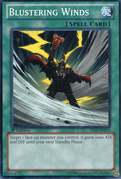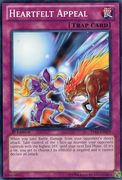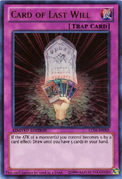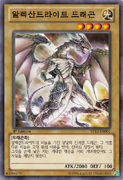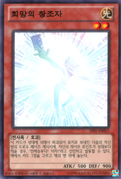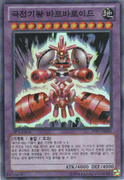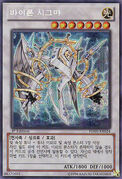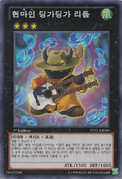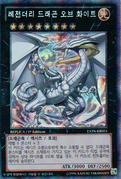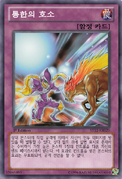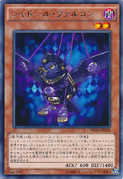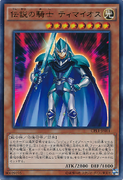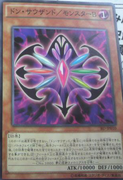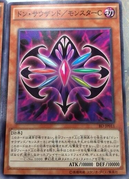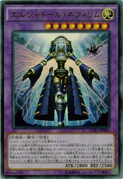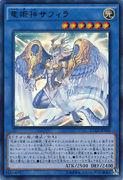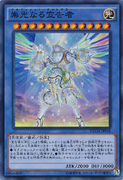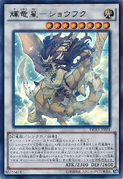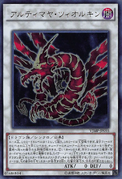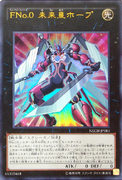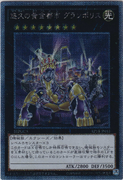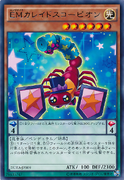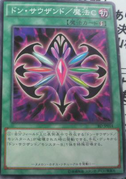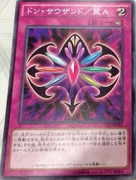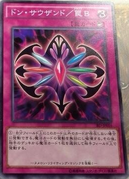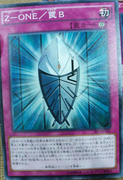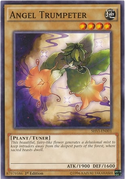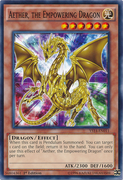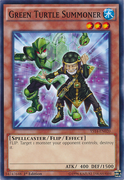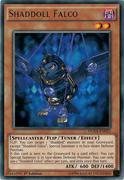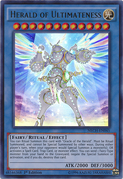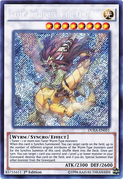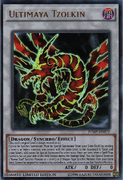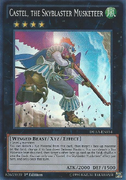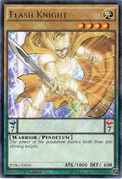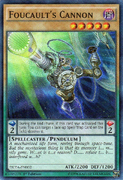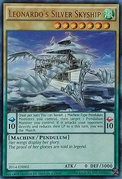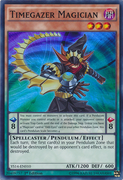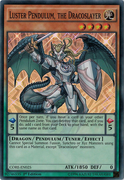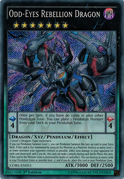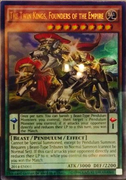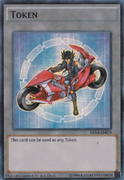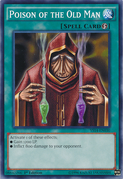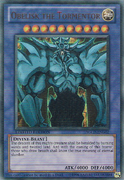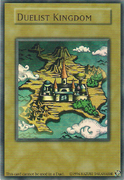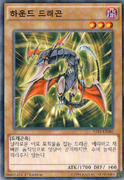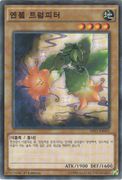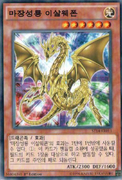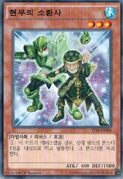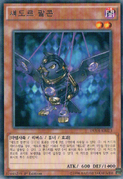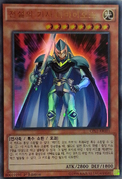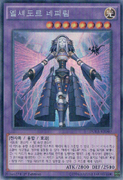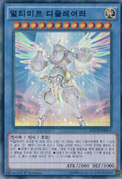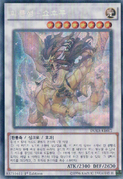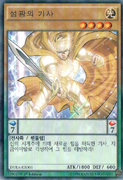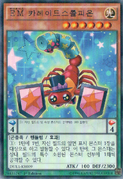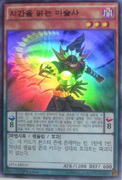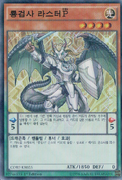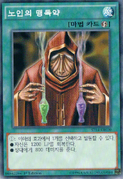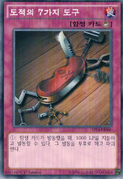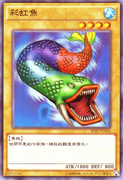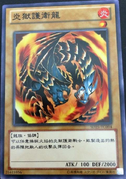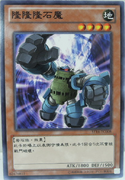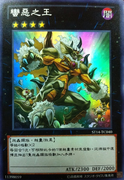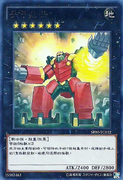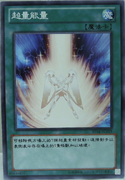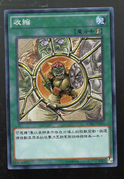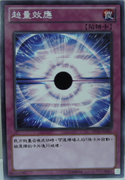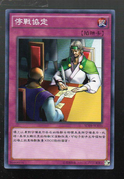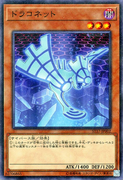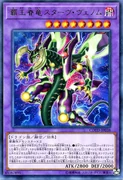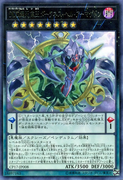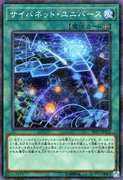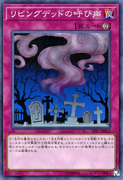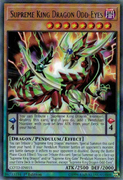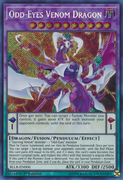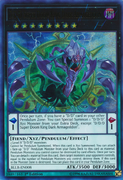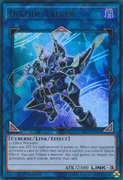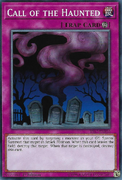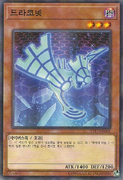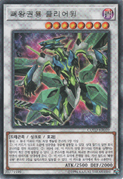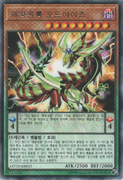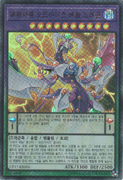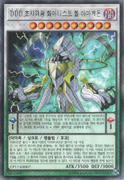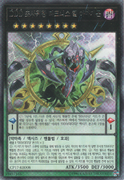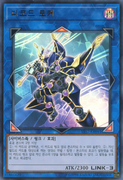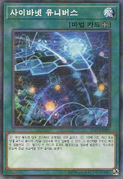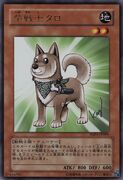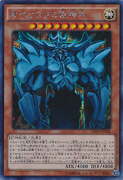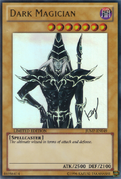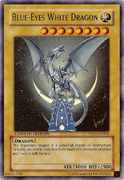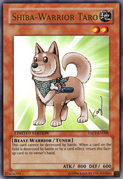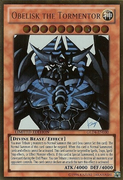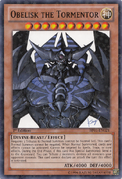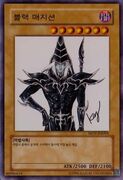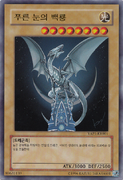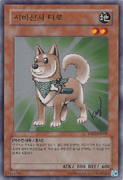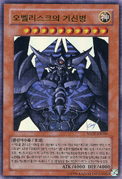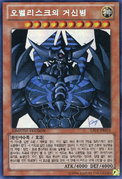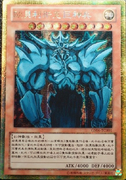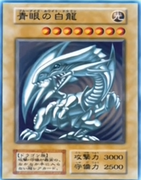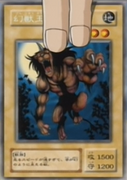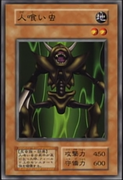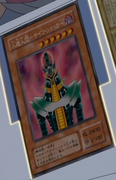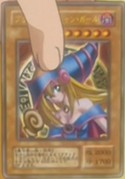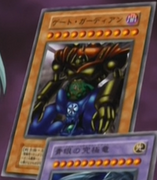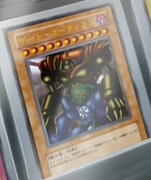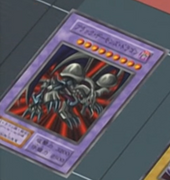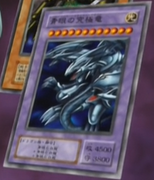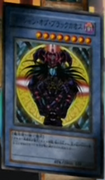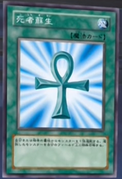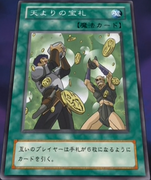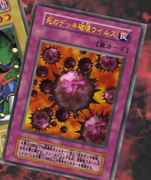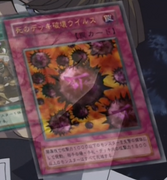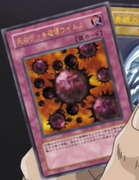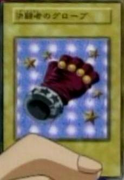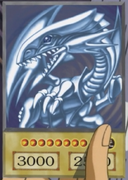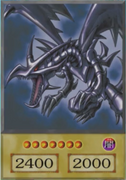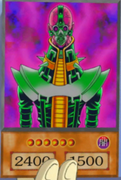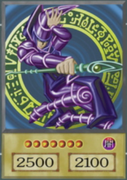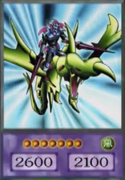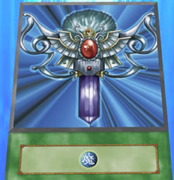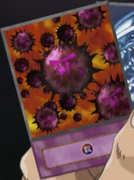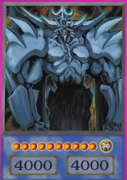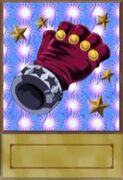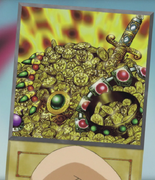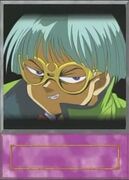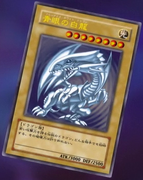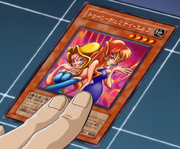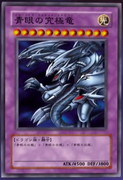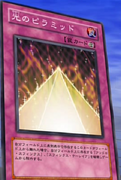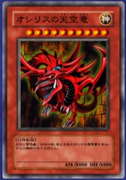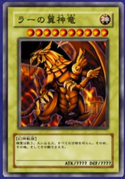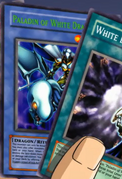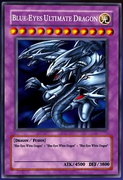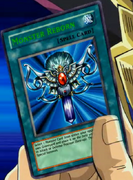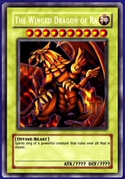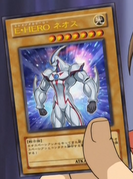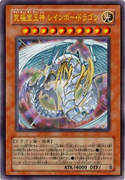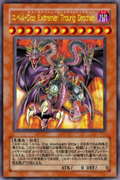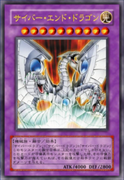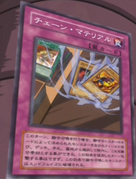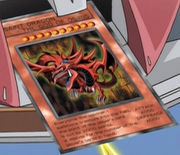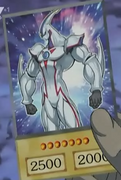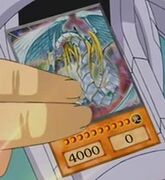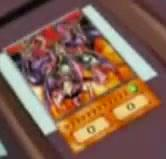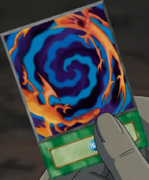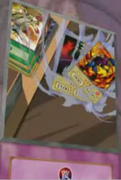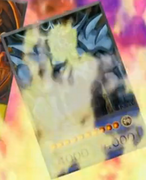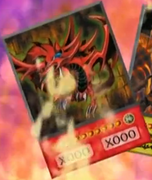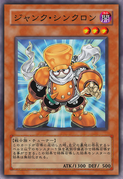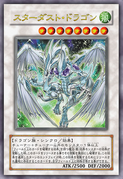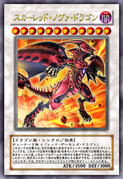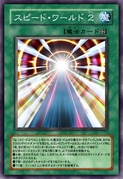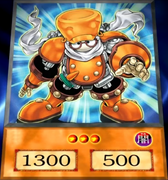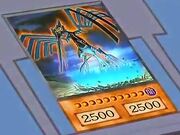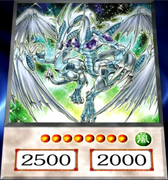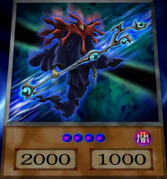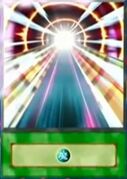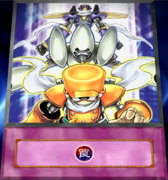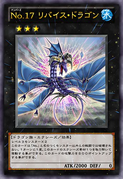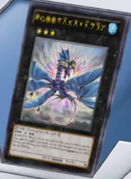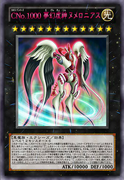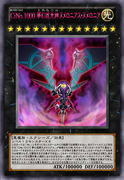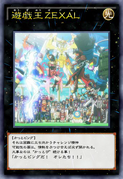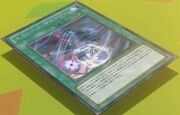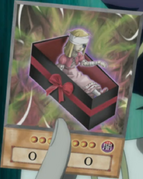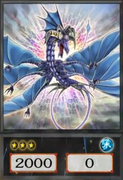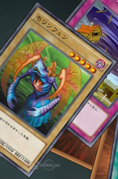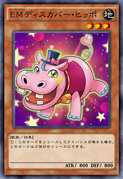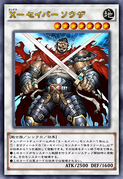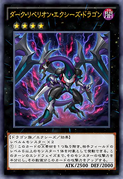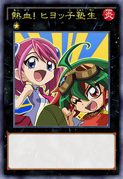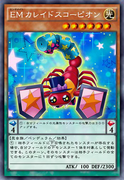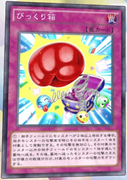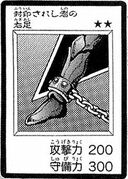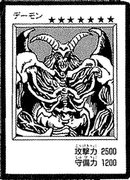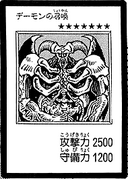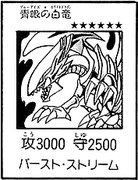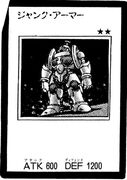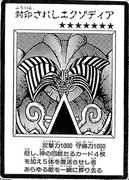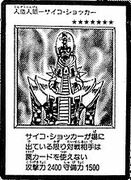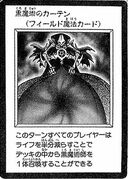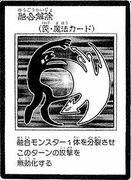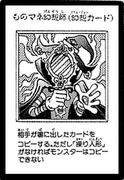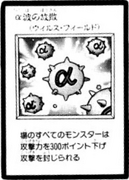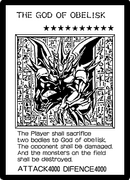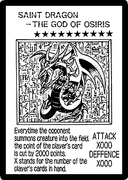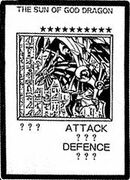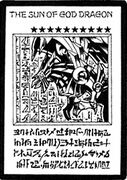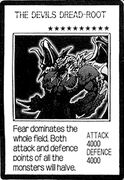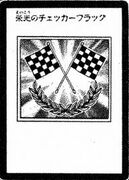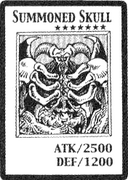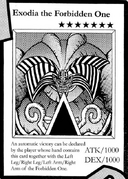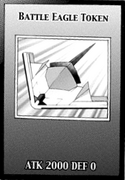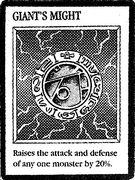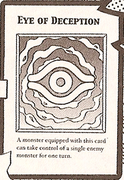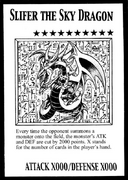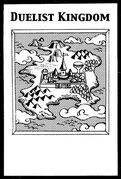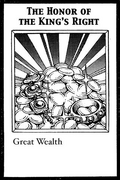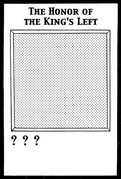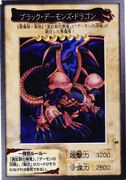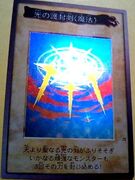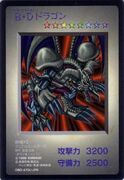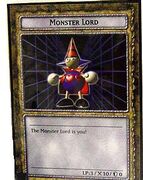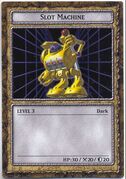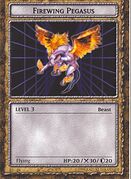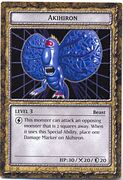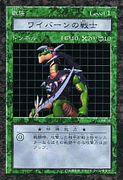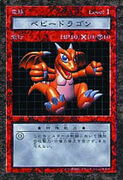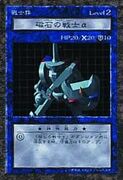A card's layout is standardized, and has undergone several changes since Konami's OCG/TCG card game and the anime was first introduced.
Description
- Card type
- Card name
- Attribute symbol
- Monster Level/Rank stars
- Spell/Trap type and type symbol
- Card image
- Card image border
- Edition text
- Card Number
- Pendulum Scale (on Pendulum Monsters)
- Link Arrows (on Link Monsters)
- Card text boxes
- Card text box borders
- Monster type
- Effect or flavor/lore text
- ATK and (DEF or Link)
- Passcode or limitation text
- Copyright text
- Eye of Anubis hologram
Typefaces
| This section needs additional citations for verification. |
Many different typefaces have been used on Yu-Gi-Oh! cards depending on the primary script(s) of the language in question and the type of text. Some of these typefaces are embedded in official rulebook PDFs.
| Language(s) (primary script(s)) | English, French, German, Italian, Portuguese & Spanish (Latin) |
Japanese (Kanji & Kana) |
Korean (Hangul) |
Cantonese & Standard Chinese (Traditional Chinese) |
|---|---|---|---|---|
| Card name base | Matrix Small Caps Regular | DF LeiSho Semi-Bold | HY Yaeso Medium (prior to Starter Deck 2011) Asia Yeseoche Bold |
HanWang LiSu Medium |
| Card name ruby | - | Rodin Bold | Sandoll Book Bold | - |
| Attribute base | DF Reisho Semi-Bold | |||
| Attribute ruby | ITC Serif Bold | Rodin Bold | Sandoll Book Bold | - |
| "[Spell Card]" / "[Trap Card]" text base | ITC Serif Small Caps Bold | DF Reisho Semi-Bold | Sandoll Book Bold | HanWang LiSu Semi-Bold |
| "[Spell Card]" / "[Trap Card]" text ruby | - | Rodin Medium | - | |
| "1st Edition" text | ITC Serif Bold | - | ITC Serif Bold | - |
| "LIMITED EDITION" text | ITC Serif Semi-Bold | |||
| "DUEL TERMINAL" text | Gothic Bold | - | ||
| "REPLICA" text | ITC Serif Semi-Bold | ITC Serif Bold | - | |
| Card Number | ITC Serif Regular | Gothic Regular (series 2) ITC Serif Semi-Bold (series 3 and later) |
ITC Serif Regular | ITC Serif Semi-Bold |
| Type & Ability base | ITC Serif Small Caps Bold | DF Reisho Semi-Bold | Sandoll Book Bold | HanWang LiSu Semi-Bold |
| Type & Ability ruby | - | Rodin Medium | - | |
| Lore base | ITC Serif Italic (flavor text) Matrix Regular (effect text, and flavor text of the illegal Egyptian God cards) |
DF Reisho Semi-Bold | Sandoll Book Light | HanWang LiSu Semi-Bold |
| Lore ruby | - | Rodin Medium | - | |
| ATK/DEF | Matrix Small Caps Regular | DF Reisho Semi-Bold (series 2 and earlier) Matrix Small Caps Bold (series 3 and later) |
Matrix Small Caps Regular | Matrix Small Caps Bold |
| Pendulum Scale value | - | Matrix Small Caps Bold | - | |
| Passcode | ITC Serif Regular | |||
| Limitation text | ITC Serif Semi-Bold | Rodin Medium | Sandoll Gothic Light | - |
| "Replica" text | - | ITC Serif Semi-Bold | - | |
| Copyright | ITC Serif Regular | Rodin Medium | ITC Serif Regular | Rodin Medium |
History
Series 1 layout
This was the first version of layout for cards, lasting from the initial release of the Official Card Game with Vol.1 to the end of Series 1 with the release of Dark Ceremony Edition. This layout was used in early episode of the second series of Yu-Gi-Oh!
Cards with this version of the layout are characterized by a larger card image and, for Monster Cards, two half-width boxes below the picture, side-by-side, with the left one for the monster's card effect or lore, and the right one for its ATK and DEF, which use the terms
Series 1 cards lack Card Numbers and the Eye of Anubis Hologram.
|
An example of the Series 1 layout on illegal Normal Monster Cards. This is "Zera the Mant", from the Yu-Gi-Oh! Duel Monsters National Tournament prize cards. An example of the Series 1 layout on Level 11 Effect Monster Cards. This is "Gate Guardian", from the Yu-Gi-Oh! Duel Monsters National Tournament prize cards. An example of the Series 1 layout on Fusion Monster Cards with 2 Fusion Materials. This is "Flame Swordsman", from Starter Box: Theatrical Release. An example of the Series 1 layout on Level 12 Fusion Monster Cards with 3 Fusion Materials. This is "Blue-Eyes Ultimate Dragon", from the Yu-Gi-Oh! Duel Monsters National Tournament prize cards. An example of the Series 1 layout on Ritual Monster Cards. This is "Super War-Lion", from Premium Pack 2. An example of the Series 1 layout on Spell Cards. This is "Dark Hole", from Vol.1. An example of the Series 1 layout on Field Spell Cards. This is "Mountain", from Starter Box: Theatrical Release. An example of the Series 1 layout on Trap Cards. This is "Trap Hole", from Vol.1. An example of the Series 1 layout on non-game cards. This is "Understanding the Role of Cards", from Booster 3. An example of the Series 1 layout on non-game cards. This is an FAQ card, from Booster 6. |
|
An example of the Series 1 layout on Normal Monster Cards. This is "Dark Magician", a Weekly Shōnen Jump promotional card. |
|
An example of the Series 1 layout on Normal Monster Cards. This is "Dark Magician", a V Jump promotional card. |
Series 2 layout
The next version of card layout was used for the duration of Series 2, being introduced with the release of Magic Ruler and lasting until Pharaonic Guardian and Structure Deck: Pegasus (which were released on the same day).
The difference between this version and the first one is the widening of the effect/lore box on Monster Cards to about two-thirds of the card's width, featuring a new look of the box border, and a corresponding narrowing of the ATK/DEF box, achieved mainly by shortening the terms for "ATK" and "DEF" to just
This version introduces Card Numbers and the Eye of Anubis Hologram.
|
An example of the Series 2 layout on Normal Monster Cards. This is "Blue-Eyes White Dragon", from Legend of Blue Eyes White Dragon. An example of the Series 2 layout on Effect Monster Cards. This is "Penguin Knight", from Magic Ruler. An example of the Series 2 layout on illegal Effect Monster Cards. This is "Masahiro the Dark Clown", from the Second National Tournament prize cards. An example of the Series 2 layout on non-Effect Fusion Monster Cards with 2 Fusion Materials. This is "Charubin the Fire Knight", from Legend of Blue Eyes White Dragon. An example of the Series 2 layout on Effect Fusion Monster Cards. This is "Alligator's Sword Dragon", from Structure Deck: Joey. An example of the Series 2 layout on Level 12 Fusion Monster Cards with 3 Fusion Materials. This is "Blue-Eyes Ultimate Dragon", from the Second National Tournament prize cards. An example of the Series 2 layout on illegal Fusion Monster Cards. This is "Yasushi the Skull Knight", from the Second National Tournament prize cards. An example of the Series 2 layout on Ritual Monster Cards. This is "Crab Turtle", from Pharaoh's Servant. An example of the Series 2 layout on Spell Cards. This is "Raigeki", from Legend of Blue Eyes White Dragon. An example of the Series 2 layout on Equip Spell Cards. This is "Axe of Despair", from Magic Ruler. An example of the Series 2 layout on Trap Cards. This is "Fairy's Hand Mirror", from Magic Ruler. An example of the Series 2 layout on the "Obelisk the Tormentor" illegal card, from Yu-Gi-Oh! Duel Monsters 4: Battle of Great Duelist: Kaiba Deck promotional cards. An example of the Series 2 layout on the "Slifer the Sky Dragon" illegal card, from Yu-Gi-Oh! Duel Monsters 4: Battle of Great Duelist: Yugi Deck promotional cards. An example of the Series 2 layout on "The Winged Dragon of Ra" illegal card, from Yu-Gi-Oh! Duel Monsters 4: Battle of Great Duelist: Jonouchi Deck promotional cards. An example of the Series 2 layout on non-game cards. This is "Duelist ID Card", a Konami official tournament 2000 participation card. An example of the Series 2 layout on non-game cards. This is "Duelist Kingdom", from Structure Deck: Pegasus. An example of the Series 2 layout on non-game cards. This is an Expert Rule Card, from Booster R1. An example of the Series 2 layout on non-game cards. This is an Expert Rule Card (front), from Booster R1. An example of the Series 2 layout on non-game cards. This is a Junior Rule Card, from Booster R2. An example of the Series 2 layout on non-game cards. This is a Junior Rule Card (front), from Booster R2. An example of the Series 2 layout on non-game cards. This is a Combo Rule Card, from Booster R3. |
|
An example of the Series 2 layout on Normal Monster Cards. This is "Blue-Eyes White Dragon", from Structure Deck: Kaiba. |
|
An example of the Series 2 layout on Normal Monster Cards. This is "Blue-Eyes White Dragon", from Structure Deck: Kaiba. |
Series 3 layout
The third, and by far longest-lived, version of card layout was introduced with Series 3, beginning with Limited Edition 4, and is the card layout that the TCG was introduced with. It has been called the World Unified Format (世界統一フォーマット Sekai Tōitsu Fōmatto).
This version is marked by a shorter, square card image and a unified, taller box for the card effect/lore and ATK/DEF. OCG cards feature the English text "ATK" and "DEF", and three-character set prefixes (with the uses of one of the Matrix fonts) and three-digit set position numbers are introduced (with the uses of one of the ITC Stone fonts). Level 12 monsters have their Level Stars aligned to the right and put closer together unlike lower Level monsters. In early sets of this series, Spell Cards (
Interestingly, this layout was released internationally before the end of series 2 in Japan: while the final series 2 sets were released on March 21, 2002, the first series 3 set was released on March 8, and the private release Summoned Skull Sample promotional card was distributed in December 2001.
|
An example of the Series 3 layout on Normal Monster Cards. This is "Queen's Knight", from Limited Edition 4. An example of the Series 3 layout on Effect Monster Cards. This is "King's Knight", from Limited Edition 4. An example of the Series 3 layout on Fusion Monster Cards. This is "Reaper on the Nightmare", from The New Ruler. An example of the Series 3 layout on Level 12 Fusion Monster Cards. This is "Five-Headed Dragon", from Yu-Gi-Oh! Duel Monsters 7: The Duel City Legend promotional cards. An example of the Series 3 layout on Ritual Monster Cards. This is "Relinquished", from Duelist Legacy Volume.1. An example of the Series 3 layout on Magic Cards. This is "Mystical Space Typhoon", from Structure Deck: Yugi Volume 2. An example of the Series 3 layout on Spell Cards. This is "Mystical Space Typhoon", from Structure Deck: Marik. An example of the Series 3 layout on Trap Cards. This is "Relieve Monster", from Limited Edition 4. |
|
An example of the Series 3 layout on Normal Monster Cards. This is "Mystical Elf", from Starter Deck: Yugi. An example of the Series 3 layout on Effect Monster Cards. This is "Wall of Illusion", from Starter Deck: Yugi. An example of the Series 3 layout on Fusion Monster Cards. This is "Reaper on the Nightmare", from Pharaonic Guardian. An example of the Series 3 layout on Ritual Monster Cards. This is "Relinquished", from Magic Ruler. An example of the Series 3 layout on Magic Cards. This is "Mystical Space Typhoon", from Magic Ruler. An example of the Series 3 layout on Spell Cards. This is "Mystical Space Typhoon", from Spell Ruler. An example of the Series 3 layout on Trap Cards. This is "Reinforcements", from Starter Deck: Yugi. |
Series 4 layout
This layout, introduced with Series 4, was a small update to the Series 3 layout which added two-letter region identifiers for all Card Numbers; previously, they had frequently been omitted for North American English and Japanese cards.
|
An example of the Series 3 layout on non-game cards. This is "Duelist Name Card", a Konami official tournament 2004 participation card. |
|
An example of the Series 4 layout on illegal Spell Cards. This is "Get Your Game On!", a Yu-Gi-Oh! World Championship 2007 prize card. An example of the Series 3 layout on the "Obelisk the Tormentor" illegal card, a Shonen Jump promotional card. An example of the Series 3 layout on the "Slifer the Sky Dragon" illegal card, a Yu-Gi-Oh! The Movie Ani-Manga promotional card. An example of the Series 3 layout on "The Winged Dragon of Ra" illegal card, a Yu-Gi-Oh! The Dawn of Destiny promotional card. An example of the Series 4 layout on Tip Cards. This is ""Command Knight"" (front), from Dark Beginning 2. |
Series 5 layout
Introduced with Series 5 with the release of Power of the Duelist, this layout introduced four-character set prefixes for Card Numbers to allow for Structure Deck: Machine Re-Volt, which had the set prefix "SD10". Like the Series 4 layout, this layout was otherwise identical to the Series 3 layout; Level 12 monsters have their Level Stars aligned to the center.
|
An example of the Series 5 layout on Level 12 Fusion Monster Cards. This is "Five-Headed Dragon", from Beginner's Edition 2. An example of the Series 5 layout on Monster Token Cards. This is "Fluff Token", from Tournament Pack 2007 Vol.1. |
|
An example of the Series 5 layout on illegal Effect Monster Cards. This is "Chimaera, the Master of Beasts", a Yu-Gi-Oh! World Championship 2007 prize card. An example of the Series 5 layout on Level 12 Fusion Monster Cards. This is "Five-Headed Dragon", from Structure Deck - Dinosaur's Rage Special Set. An example of the Series 5 layout on Strategy Cards. This is "Goblin Double Strike!", from Duelist Pack: Jaden Yuki 3. An example of the Series 5 layout on Strategy Cards. This is "Duelist Pack -JADEN YUKI 3- Checklist", from Duelist Pack: Jaden Yuki 3. |
|
An example of the Series 5 layout on Level 12 Fusion Monster Cards. This is "Five-Headed Dragon", from Structure Deck: Revival of the Great Dragon Special Edition. An example of the Series 5 layout on Monster Token Cards. This is "Tiger Token", from Anniversary Pack. An example of the Series 5 layout on the "Obelisk the Tormentor" illegal card, a Yu-Gi-Oh! World Championship 2008 promotional card. An example of the Series 5 layout on the "Slifer the Sky Dragon" illegal card, a Yu-Gi-Oh! World Championship 2008 promotional card. An example of the Series 5 layout on the "The Winged Dragon of Ra" illegal card, a Yu-Gi-Oh! World Championship 2008 promotional card. |
Series 6 layout
This layout was introduced with Series 6, and featured the furigana on the names of Monster Cards being unified to black to accommodate the accompanying introduction of Synchro Monsters; prior to this, some monster furigana was printed in white.
|
An example of the Series 6 layout on Tuner Normal Monster Cards. This is "Water Spirit", from Starter Deck 2008. An example of the Series 6 layout on Synchro Monster Cards. This is "Brionac, Dragon of the Ice Barrier", from Duel Terminal - Synchro Awakening!!. |
|
An example of the Series 6 layout on Tuner Normal Monster Cards. This is "Water Spirit", from Starter Deck: Yu-Gi-Oh! 5D's. An example of the Series 6 layout on Synchro Monster Cards. This is "Brionac, Dragon of the Ice Barrier", from Hidden Arsenal. |
|
An example of the Series 6 layout on Normal Monster Cards. This is "Beta The Magnet Warrior", from Duelist Pack: Yugi. An example of the Series 6 layout on Tuner Normal Monster Cards. This is "Water Spirit", from Starter Deck 2008. An example of the Series 6 layout on Effect Monster Cards. This is "Gorz the Emissary of Darkness", from Duelist Pack: Yugi. An example of the Series 6 layout on Fusion Monster Cards. This is "Dark Paladin", from Duelist Pack: Yugi. An example of the Series 6 layout on Ritual Monster Cards. This is "Black Luster Soldier", from Duelist Pack: Yugi. An example of the Series 6 layout on Synchro Monster Cards. This is "Brionac, Dragon of the Ice Barrier", a Jump Festa Invitational 2009 promotional card. An example of the Series 6 layout on Spell Cards. This is "Polymerization", from Duelist Pack: Yugi. An example of the Series 6 layout on Trap Cards. This is "Magical Hats", from Duelist Pack: Yugi. |
Series 7 layout
Introduced with Series 7 with the release of Starter Deck 2010, a few more small changes were made. These included lightening the background of the effect box to make the text easier to read, and making the effect box taller and wider to allow for cards with longer effects. The card image and name box were shifted slightly upward to allow for the larger effect box, and the name box was widened to maintain roughly equal margins on its sides and top. The font used for Korean cards' names was changed since Starter Deck 2011. This layout is used in Yu-Gi-Oh! ZEXAL.
|
An example of the Series 7 layout on Normal Monster Cards. This is "Battle Footballer", from Starter Deck 2010. An example of the Series 7 layout on Tuner Normal Monster Cards. This is "Tune Warrior", from Starter Deck 2010. An example of the Series 7 layout on Effect Monster Cards. This is "Rapid Warrior", from Starter Deck 2010. An example of the Series 7 layout on Fusion Monster Cards. This is "Chimeratech Fortress Dragon", from Gold Series 2011. An example of the Series 7 layout on Ritual Monster Cards. This is "Evigishki Mind Augus", from Duel Terminal - Raid of the Inverz!!. An example of the Series 7 layout on Synchro Monster Cards. This is "T.G. Wonder Magician", from Extreme Victory. An example of the Series 7 layout on Level 12 Synchro Monster Cards. This is "Shooting Quasar Dragon", a Master Guide 3 promotional cards. An example of the Series 7 layout on Xyz Monster Cards. This is "Number 39: Utopia", from Starter Deck 2011. An example of the Series 7 layout on Monster Token Cards. This is "Kuriboh Token", from Jump Festa 2011 - Promotion Pack. An example of the Series 7 layout on Spell Cards. This is "Half Shut", from Starter Deck 2010. An example of the Series 7 layout on Trap Cards. This is "Wild Tornado", from Starter Deck 2010. |
|
An example of the Series 7 layout on Normal Monster Cards. This is "Battle Footballer", from Starter Deck: Duelist Toolbox. An example of the Series 7 layout on Tuner Normal Monster Cards. This is "Tune Warrior", from Starter Deck: Duelist Toolbox. An example of the Series 7 layout on Effect Monster Cards. This is "Rapid Warrior", from Starter Deck: Duelist Toolbox. An example of the Series 7 layout on Fusion Monster Cards. This is "Chimeratech Fortress Dragon", from Black-Winged Dragon Collectible Tin. An example of the Series 7 layout on Ritual Monster Cards. This is "Evigishki Mind Augus", from Hidden Arsenal 5: Steelswarm Invasion. An example of the Series 7 layout on Synchro Monster Cards. This is "T.G. Wonder Magician", from Duelist Revolution. An example of the Series 7 layout on Level 12 Synchro Monster Cards. This is "Shooting Quasar Dragon", a Shonen Jump promotional card. An example of the Series 7 layout on illegal Synchro Monster Cards. This is "Stardust Divinity", a Yu-Gi-Oh! World Championship 2010 prize card. An example of the Series 7 layout on Xyz Monster Cards. This is "Number 39: Utopia", from Starter Deck: Dawn of the Xyz. An example of the Series 7 layout on illegal Xyz Monster Cards. This is "Queen Nereia the Silvercrown", a Yu-Gi-Oh! World Championship 2011 prize card. An example of the Series 7 layout on Spell Cards. This is "Half Shut", from Starter Deck: Duelist Toolbox. An example of the Series 7 layout on Trap Cards. This is "Wild Tornado", from Starter Deck: Duelist Toolbox. An example of the Series 7 layout on the "Obelisk the Tormentor" illegal card, from Legendary Collection. An example of the Series 7 layout on the "Slifer the Sky Dragon" illegal card, from Legendary Collection. An example of the Series 7 layout on "The Winged Dragon of Ra" illegal card, from Legendary Collection. An example of the Series 7 layout on Strategy Cards. This is "Whirlwind Special!", from Duelist Pack: Crow. An example of the Series 7 layout on Strategy Cards. This is "Duelist Pack: Crow checklist", from Duelist Pack: Crow. |
|
An example of the Series 7 layout on Normal Monster Cards. This is "Hieratic Seal of the Sun Dragon Overlord", from Galactic Overlord . An example of the Series 7 layout on Tuner Normal Monster Cards. This is "Tune Warrior", from Starter Deck 2010. An example of the Series 7 layout on Effect Monster Cards. This is "Gagaga Magician", from Duelist Pack: Yuma. An example of the Series 7 layout on Fusion Monster Cards. This is "Chimeratech Fortress Dragon", from Gold Series 2011. An example of the Series 7 layout on Ritual Monster Cards. This is "Magician of Black Chaos", from Tournament Pack 2009 Vol.2. An example of the Series 7 layout on Synchro Monster Cards. This is "T.G. Wonder Magician", from Extreme Victory. An example of the Series 7 layout on Level 12 Synchro Monster Cards. This is "Shooting Quasar Dragon", from Duelist Playmat Edition. An example of the Series 7 layout on Xyz Monster Cards. This is "Number 39: Utopia", from Duelist Pack: Yuma. An example of the Series 7 layout on Monster Token Cards. This is "Fluff Token", from Tournament Pack 2011 Vol.9. An example of the Series 7 layout on Spell Cards. This is "Thunder Short", from Duelist Pack: Yuma. An example of the Series 7 layout on Trap Cards. This is "Asleep at the Switch", from Duelist Pack: Yuma. An example of the Series 7 layout on Strategy Cards, from Duelist Pack: Yuma. An example of the Series 7 layout on Strategy Cards. This is a Checklist card, from Duelist Pack: Yuma. |
Series 8 layout
Introduced with Series 8 with the release of Starter Deck 2012, other small changes were made. These include larger artwork and Level/Rank stars on Monster Cards, with very little extra space around the stars and attribute icon. On cards with a short effect or flavor text, the text is printed in a larger font size, making it easier to read. Some of the TCG versions of Monster Tokens have the bar over the ATK and DEF signs added, while OCG tokens have been changed to look much more like regular Monster Cards, with the Token's name, Attribute icon, Level stars, ATK and DEF, and extra detail in the lore; some Tokens of the characters from Yu-Gi-Oh! media include some of their theme lines in the card text box, while others also have the V Jump logo as a watermark featured on the background of the box. The kanji in the attribute icons of Japanese Spell and Trap Cards are slightly repositioned to be more centered; the icons on TCG cards are unchanged.
|
An example of the Series 8 layout on Normal Monster Cards. This is "Alexandrite Dragon", from Starter Deck 2012. An example of the Series 8 layout on Tuner Normal Monster Cards. This is "Flamvell Guard", from Structure Deck: The Blue-Eyed Dragon's Thundering Descent. An example of the Series 8 layout on Effect Monster Cards. This is "Zubaba Knight", from Starter Deck 2012. An example of the Series 8 layout on illegal Effect Monster Cards. This is "Creator of Hope", from Advanced Tournament Pack 2013 Vol.2. An example of the Series 8 layout on Fusion Monster Cards. This is "Chimeratech Overdragon", from Duelist Edition Volume 1. An example of the Series 8 layout on Ritual Monster Cards. This is "Evigishki Gustkraken", from Duel Terminal Chronicle 1 - Chapter of Awakening. An example of the Series 8 layout on Synchro Monster Cards. This is "Giganticastle", from Shadow Specters. An example of the Series 8 layout on Xyz Monster Cards. This is "Muzurhythm the String Djinn", from Starter Deck 2012. An example of the Series 8 layout on illegal Xyz Monster Cards. This is "Legendary Dragon of White", from Extra Pack: Sword of Knights. An example of the Series 8 layout on Monster Token Cards without a watermark. This is a "Mecha Phantom Beast Token" (Megaraptor version), from Advanced Tournament Pack 2013 Vol.1. An example of the Series 8 layout on Monster Token Cards with a V Jump logo watermark. This is a "Mecha Phantom Beast Token" (Tetherwolf version), a V Jump April 2013 Token. An example of the Series 8 layout on Character Token Cards with one character's saying and no watermark. This is "Token (Rio Kastle)", from Promotion Pack 3: Part A. An example of the Series 8 layout on Character Token Cards with one character's saying and a V Jump logo watermark. This is "Yusei Token", a April 2013 Token. An example of the Series 8 layout on Character Token Cards with two characters' sayings. This is "Kite & Mizar Token", from Concept Duel 3. An example of the Series 8 layout on Character Token Cards featuring several characters with one saying and no watermark. This is "World Duel Carnival Token", from Concept Duel 2. An example of the Series 8 layout on Character Token Cards featuring several characters with one saying and a V Jump logo watermark. This is "Numbers Club Token", a V Jump April 2013 Token. An example of the Series 8 layout on Monster Token Cards as a parody. This is "Charisma Token", a promotional card. An example of the Series 8 layout on Monster Token Cards as anniversary cards. This is "15th Anniversary Token", from Memories of the Duel King: Duelist Kingdom Arc. An example of the Series 8 layout on Spell Cards. This is "Blustering Winds", from Starter Deck 2012. An example of the Series 8 layout on Trap Cards. This is "Heartfelt Appeal", from Starter Deck 2012. An example of the Series 8 layout on non-game cards. This is a "Command Duel-Use Card", from Advanced Tournament Pack 2014 Vol.1. An example of the Series 8 layout on non-game cards. This is a "Command Duel-Use Card". An example of the Series 8 layout on non-game cards. This is a "DUEL CHECKER" card, from Advanced Tournament Pack 2014 Vol.1. An example of the Series 8 layout on non-game cards. This is a "Special Phase Card" (front), from Advanced Tournament Pack 2013 Vol.3. An example of the Series 8 layout on non-game cards. This is a "Special Phase Card" (back), from Advanced Tournament Pack 2013 Vol.3. An example of the Series 2 layout on the "Slifer the Sky Dragon" illegal card, from Memories of the Duel King: Duelist Kingdom Arc. An example of the Series 1 layout on non-game cards. This is "Set Sail for The Kingdom", from Memories of the Duel King: Duelist Kingdom Arc. |
|
An example of the Series 8 layout on Normal Monster Cards. This is "Alexandrite Dragon", from Starter Deck: Xyz Symphony. An example of the Series 8 layout on Tuner Normal Monster Cards. This is "Flamvell Guard", from Saga of Blue-Eyes White Dragon Structure Deck. An example of the Series 8 layout on Effect Monster Cards. This is "Zubaba Knight", from Starter Deck: Xyz Symphony. An example of the Series 8 layout on Fusion Monster Cards. This is "Chimeratech Overdragon", from Premium Gold. An example of the Series 8 layout on Level 12 Fusion Monster Cards. This is "Barbaroid, the Ultimate Battle Machine", from Star Pack 2013. An example of the Series 8 layout on Ritual Monster Cards. This is "Evigishki Gustkraken", from Hidden Arsenal 6: Omega Xyz. An example of the Series 8 layout on Synchro Monster Cards. This is "Giganticastle", from Shadow Specters. An example of the Series 8 layout on Xyz Monster Cards. This is "Muzurhythm the String Djinn", from Starter Deck: Xyz Symphony. An example of the Series 8 layout on illegal Xyz Monster Cards. This is "Legendary Dragon of White", a Yu-Gi-Oh! World Championship 2012 prize card. An example of the Series 8 layout on Monster Token Cards without the bar in the lore box. This is a "Mecha Phantom Beast Token" (Harrliard version), from Battle City Tournament Kit. An example of the Series 8 layout on Monster Token Cards with the bar in the lore box. This is "Kuriboh Token", from Legendary Collection 3: Yugi's World. An example of the Series 8 layout on Spell Cards. This is "Blustering Winds", from Starter Deck: Xyz Symphony. An example of the Series 8 layout on Trap Cards. This is "Heartfelt Appeal", from Starter Deck: Xyz Symphony. An example of the Series 8 layout on illegal Trap Cards. This is "Card of Last Will", from Legendary Collection 4: Joey's World. |
|
An example of the Series 8 layout on Normal Monster Cards. This is "Alexandrite Dragon", from Starter Deck 2012. An example of the Series 8 layout on Tuner Normal Monster Cards. This is "Flamvell Guard", from Structure Deck: The Blue-Eyed Dragon's Thundering Descent. An example of the Series 8 layout on Effect Monster Cards. This is "Zubaba Knight", from Starter Deck 2012. An example of the Series 8 layout on illegal Effect Monster Cards. This is "Creator of Hope", from Advanced Event Pack 2013 Vol.1. An example of the Series 8 layout on Fusion Monster Cards. This is "Gem-Knight Topaz", from Hidden Arsenal 5: Steelswarm Invasion. An example of the Series 8 layout on Level 12 Fusion Monster Cards. This is "Barbaroid, the Ultimate Battle Machine", from Premium Pack Vol.7. An example of the Series 8 layout on Ritual Monster Cards. This is "Evigishki Soul Ogre", from Hidden Arsenal 5. An example of the Series 8 layout on Synchro Monster Cards. This is "Vylon Sigma", from Hidden Arsenal 5. An example of the Series 8 layout on Xyz Monster Cards. This is "Muzurhythm the String Djinn", from Starter Deck 2012. An example of the Series 8 layout on illegal Xyz Monster Cards. This is "Legendary Dragon of White", from Extra Pack: Sword of Knights. An example of the Series 8 layout on Monster Token Cards. This is "Laval Token", from Promotion Pack 2012 Vol.2. An example of the Series 8 layout on Monster Token Cards. This is "Mecha Phantom Beast Token" (Megaraptor version), from Advanced Event Pack 2013 Vol.1. An example of the Series 8 layout on Character Token Cards. This is "Token (Rio Kastle)", from Promotion Pack 2013 Vol.3. An example of the Series 8 layout on Spell Cards. This is "Blustering Winds", from Starter Deck 2012. An example of the Series 8 layout on Trap Cards. This is "Heartfelt Appeal", from Starter Deck 2012. An example of the Series 8 layout on non-game cards. This is a "DUEL CHECKER" card, from Advanced Event Pack 2014 Vol.1. |
Series 9 layout
This layout was introduced with Series 9 with Starter Deck 2014. It added Pendulum Monsters, which feature an artwork box that has been widened to line up with the card description box; the background of the Pendulum Effect and Pendulum Scale boxes are slightly transparent and the main lore box is even more slightly transparent from top to bottom, allowing the overlapped portion of the artwork to be seen, which makes Pendulum Monsters' artworks be almost fully shown unlike any other card type before. Some cards with long Pendulum Effect text have increased height for the text box. The artwork, Pendulum Scale, Pendulum Effect and main lore boxes are put in gray frames instead of the traditional orange frames. The Card Number for Pendulum Monsters is placed on the left-bottom of the main lore box.
For all cards, the main lore box has been slightly widened, while the card name box has become shorter and wider; this leads to the reduced size of the card's name and Attribute symbol, and allows more room for Level/Rank stars on Monster Cards as well as Spell/Trap property indicators. Additionally, the aforementioned stars and text/indicators have been made smaller; these changes slightly increase the padding in that area of the card, compared to the Series 8 layout which drastically reduced it. Also, the edition text (e.g. "1st Edition") is placed right next to the passcode. If the monster's main lore gets too long, the font size of the Type/Ability text is reduced to provide more space.
Several changes are also made in the Japanese and Korean terminology and card grammar: for the first time, Flip (リバース) is treated as an Ability similar to Tuner, Union, Gemini, etc. and is listed next to the monster's Type in the card description; the word 効果 (Effect) is now always written on the Type/Ability line for monsters with Abilities that have effects, being omitted in the past; these changes are also applied to TCG cards, although the word "FLIP" is still kept in the card text; as for TCG Flip Effect Monsters that have an effect other than its Flip Effect, that effect is written in another paragraph. The middle dot (・) is no longer used on the type line on Japanese prints. Some terms like "Life Points", "Synchro", "Xyz" and "Pendulum" are abbreviated in the card text as "LP", "S", "X", and "P" respectively with appropriate furigana so as to take up less space; so far, only the term "Life Points" is known to be abbreviated in TCG and Korean card text.
Japanese and Korean card text now follows a new pattern similar to the TCG Problem-Solving Card Text: Marking circled number:Timing/Targeting (if any), Costs (if any). Resolution. Each effect is written in at least one sentence and marked with a circled number (①, ②, etc.); thus any text written before the number 1 (①) is not an effect and cannot be negated by the effects of cards such as "Skill Drain". The effect's timing, targeting, and costs follow the effect number and colon in one sentence; timing and targeting are separated from costs by a comma, which is dropped if an effect has no cost. The effect's action and resolution follow in a separate sentence(s).[1] Also, new text patterns used for mentioning the support for an archetype, such as 「~」カード ("~" card) or 「~」モンスター ("~" monster), begin to be used instead of the old ones such as 「~」と名のついたカード (card with "~" in its name) or 「~」と名のついたモンスター (monster with "~" in its name).[2]
Traditional Chinese cards from Series 9 used the Series 8 card frames. Starting with the release of Structure Deck: Machiners Command, the Series 9 card frames are used instead.
The Series 9 format is used in Yu-Gi-Oh! ARC-V and Yu-Gi-Oh! The Dark Side of Dimensions.
|
An example of the Series 9 layout on Normal Monster Cards. This is "Hunter Dragon", from Starter Deck 2014. An example of the Series 9 layout on Tuner Normal Monster Cards. This is "Angel Trumpeter", from Shining Victories. An example of the Series 9 layout on Effect Monster Cards. This is "Aether, the Empowering Dragon", from Starter Deck 2014. An example of the Series 9 layout on Flip monster cards. This is "Green Turtle Summoner", from Starter Deck 2014. An example of the Series 9 layout on Flip Tuner monster cards. This is "Shaddoll Falco", from Duelist Alliance. An example of the Series 9 layout on Special Summon Monster Cards. This is "Legendary Knight Timaeus", from Collectors Pack: Duelist of Legend Version. An example of the Series 9 layout on Boss Duel Effect Monster Cards. This is "Don Thousand/Monster B". An example of the Series 9 layout on Boss Duel Effect Monster Cards. This is "Z-ONE/Monster E". An example of the Series 9 layout on Boss Duel Effect Monster Cards. This is "Don Thousand/Monster C". An example of the Series 9 layout on Fusion Monster Cards. This is "El Shaddoll Construct", from Duelist Alliance. An example of the Series 9 layout on Ritual Monster Cards. This is "Saffira, Queen of Dragons", from Duelist Alliance. An example of the Series 9 layout on Level 12 Ritual Monster Cards. This is "Herald of Ultimateness", from The New Challengers. An example of the Series 9 layout on Synchro Monster Cards. This is "Baxia, Brightness of the Yang Zing", from Duelist Alliance. An example of the Series 9 layout on Level 0 Synchro Monster Cards. This is "Ultimaya Tzolkin", a V Jump February 2015 promotional card. An example of the Series 9 layout on Xyz Monster Cards. This is "Castel, the Skyblaster Musketeer", from Duelist Alliance. An example of the Series 9 layout on Rank 0 Xyz Monster Cards. This is "Number F0: Utopic Future", from The New Challengers. An example of the Series 9 layout on illegal Xyz Monster Cards. This is "Grandopolis, The Eternal Golden City", from Extra Pack: Knights of Order. An example of the Series 9 layout on Normal Pendulum Monster Cards with no Pendulum Effect. This is "Flash Knight", from Duelist Alliance. An example of the Series 9 layout on Normal Pendulum Monster Cards with short Pendulum Effect text. This is "Foucault's Cannon", from Duelist Alliance. An example of the Series 9 layout on Effect Pendulum Monster Cards with short Pendulum Effect text. This is "Performapal Kaleidoscorp", from Duelist Alliance. An example of the Series 9 layout on Effect Pendulum Monster Cards with long Pendulum Effect text. This is "Timegazer Magician", from Starter Deck 2014. An example of the Series 9 layout on Tuner Pendulum Monster Cards with long Pendulum Effect text. This is "Luster Pendulum, the Dracoslayer", from Clash of Rebellions. An example of the Series 9 layout on Xyz Pendulum Monster Cards with long Pendulum Effect text. This is "Odd-Eyes Rebellion Dragon", from Clash of Rebellions. An example of the Series 9 layout on Monster Token Cards. This is "Hippo Token", from Advanced Tournament Pack 2014 Vol.2. An example of the Series 9 layout on Character Token Cards. This is "Yuya Token", a Yu-Gi-Oh! Day May 2014 promotional card. An example of the Series 9 layout on Monster Token Cards. This is "World Championship 2014 Token" from Advanced Tournament Pack 2014 Vol.3. An example of the Series 9 layout on counter cards. This is "Wedge Counter", from Advanced Tournament Pack 2014 Vol.4. An example of the Series 9 layout on Spell Cards. This is "Poison of the Old Man", from Starter Deck 2014. An example of the Series 9 layout on Boss Duel Spell Cards. This is "Pegasus/Spell B". An example of the Series 9 layout on Boss Duel Spell Cards. This is "Don Thousand/Spell C". An example of the Series 9 layout on Trap Cards. This is "Seven Tools of the Bandit", from Starter Deck 2014. An example of the Series 9 layout on Boss Duel Trap Cards. This is "Darkness/Trap C". An example of the Series 9 layout on Boss Duel Trap Cards. This is "Don Thousand/Trap A". An example of the Series 9 layout on Boss Duel Trap Cards. This is "Don Thousand/Trap B". An example of the Series 9 layout on Boss Duel Trap Cards. This is "Z-ONE/Trap B". An example of the Series 9 layout on the "Obelisk the Tormentor" illegal card, from Memories of the Duel King: Battle City Arc. An example of the Series 9 layout on the "The Winged Dragon of Ra" illegal card, from Memories of the Duel King: Ceremonial Battle Arc. An example of the Series 9 layout on non-game cards. This is "Duelist Kingdom", from Memories of the Duel King: Battle City Arc. |
|
An example of the Series 9 layout on Normal Monster Cards. This is "Hunter Dragon", from Super Starter: Space-Time Showdown. An example of the Series 9 layout on Tuner Normal Monster Cards. This is "Angel Trumpeter", from Shining Victories. An example of the Series 9 layout on Effect Monster Cards. This is "Aether, the Empowering Dragon", from Super Starter: Space-Time Showdown. An example of the Series 9 layout on Flip monster cards. This is "Green Turtle Summoner", from Super Starter: Space-Time Showdown. An example of the Series 9 layout on Flip Tuner monster cards. This is "Shaddoll Falco", from Duelist Alliance. An example of the Series 9 layout on Fusion Monster Cards. This is "El Shaddoll Construct", from Duelist Alliance. An example of the Series 9 layout on Ritual Monster Cards. This is "Saffira, Queen of Dragons", from Duelist Alliance. An example of the Series 9 layout on Level 12 Ritual Monster Cards. This is "Herald of Ultimateness", from The New Challengers. An example of the Series 9 layout on Synchro Monster Cards. This is "Baxia, Brightness of the Yang Zing", from Duelist Alliance. An example of the Series 9 layout on Level 0 Synchro Monster Cards. This is "Ultimaya Tzolkin", a Shonen Jump promotional card. An example of the Series 9 layout on Xyz Monster Cards. This is "Castel, the Skyblaster Musketeer", from Duelist Alliance. An example of the Series 9 layout on Rank 0 Xyz Monster Cards. This is "Number F0: Utopic Future", from The New Challengers. An example of the Series 9 layout on illegal Xyz Monster Cards. This is "Grandopolis, The Eternal Golden City", a Yu-Gi-Oh! World Championship 2014 prize card. An example of the Series 9 layout on Normal Pendulum Monster Cards with no Pendulum Effect. This is "Flash Knight", from Duelist Alliance. An example of the Series 9 layout on Normal Pendulum Monster Cards with short Pendulum Effect text. This is "Foucault's Cannon", from Duelist Alliance. An example of the Series 9 layout on illegal Normal Pendulum Monster Cards with long Pendulum Effect text. This is "Leonardo's Silver Skyship", a Yu-Gi-Oh! World Championship 2014 prize card. An example of the Series 9 layout on Effect Pendulum Monster Cards with short Pendulum Effect text. This is "Performapal Kaleidoscorp", from Duelist Alliance. An example of the Series 9 layout on Effect Pendulum Monster Cards with long Pendulum Effect text. This is "Timegazer Magician", from Super Starter: Space-Time Showdown. An example of the Series 9 layout on Tuner Pendulum Monster Cards with long Pendulum Effect text. This is "Luster Pendulum, the Dracoslayer", from Clash of Rebellions. An example of the Series 9 layout on Xyz Pendulum Monster Cards with long Pendulum Effect text. This is "Odd-Eyes Rebellion Dragon", from Clash of Rebellions. An example of the Series 9 layout on illegal Effect Pendulum Monster Cards with long Pendulum Effect text. This is "The Twin Kings, Founders of the Empire", a Yu-Gi-Oh! World Championship 2014 promotional card. An example of the Series 9 layout on Character Token Cards. This is a "Token" (featuring Yusei Fudo), the Yu-Gi-Oh! Day July 2015 promotional card. An example of the Series 9 layout on Spell Cards. This is "Poison of the Old Man", from Super Starter: Space-Time Showdown. An example of the Series 9 layout on Trap Cards. This is "Seven Tools of the Bandit", from Super Starter: Space-Time Showdown. An example of the Series 9 layout on the "Obelisk the Tormentor" illegal card, from Yugi's Legendary Decks. An example of the Series 9 layout on the "Slifer the Sky Dragon" illegal card, from Yugi's Legendary Decks. An example of the Series 9 layout on the "The Winged Dragon of Ra" illegal card, from Yugi's Legendary Decks. An example of the Series 9 layout on non-game cards. This is "Duelist Kingdom", from Yugi's Legendary Decks. |
|
An example of the Series 9 layout on Normal Monster Cards. This is "Hunter Dragon", from Starter Deck 2014. An example of the Series 9 layout on Tuner Normal Monster Cards. This is "Angel Trumpeter", from Shining Victories. An example of the Series 9 layout on Effect Monster Cards. This is "Aether, the Empowering Dragon", from Starter Deck 2014. An example of the Series 9 layout on Flip monster cards. This is "Green Turtle Summoner", from Starter Deck 2014. An example of the Series 9 layout on Flip Tuner monster cards. This is "Shaddoll Falco", from Duelist Alliance. An example of the Series 9 layout on Special Summon Monster Cards. This is "Legendary Knight Timaeus", from Collectors Pack: Duelist of Legend Version. An example of the Series 9 layout on Fusion Monster Cards. This is "El Shaddoll Construct", from Duelist Alliance. An example of the Series 9 layout on Ritual Monster Cards. This is "Saffira, Queen of Dragons", from Duelist Alliance. An example of the Series 9 layout on Level 12 Ritual Monster Cards. This is "Herald of Ultimateness", from The New Challengers. An example of the Series 9 layout on Synchro Monster Cards. This is "Baxia, Brightness of the Yang Zing", from Duelist Alliance. An example of the Series 9 layout on Xyz Monster Cards. This is "Castel, the Skyblaster Musketeer", from Duelist Alliance. An example of the Series 9 layout on Normal Pendulum Monster Cards with no Pendulum Effect. This is "Flash Knight", from Duelist Alliance. An example of the Series 9 layout on Normal Pendulum Monster Cards with short Pendulum Effect text. This is "Foucault's Cannon", from Duelist Alliance. An example of the Series 9 layout on Effect Pendulum Monster Cards with short Pendulum Effect text. This is "Performapal Kaleidoscorp", from Duelist Alliance. An example of the Series 9 layout on Effect Pendulum Monster Cards with long Pendulum Effect text. This is "Timegazer Magician", from Starter Deck 2014. An example of the Series 9 layout on Tuner Pendulum Monster Cards with long Pendulum Effect text. This is "Luster Pendulum, the Dracoslayer", from Clash of Rebellions. An example of the Series 9 layout on Xyz Pendulum Monster Cards with long Pendulum Effect text. This is "Odd-Eyes Rebellion Dragon", from Clash of Rebellions. An example of the Series 9 layout on Spell Cards. This is "Poison of the Old Man", from Starter Deck 2014. An example of the Series 9 layout on Trap Cards. This is "Seven Tools of the Bandit", from Starter Deck 2014. |
|
An example of the Series 9 layout on Normal Monster Cards. This is "Gene-Warped Warwolf", from Duel Starter Deck. An example of the Series 9 layout on Normal Monster Cards. This is "7 Colored Fish", from Starter Pack Volume 2. An example of the Series 9 layout on Tuner Normal Monster Cards. This is "Flamvell Guard", from Structure Deck: The Blue-Eyed Dragon's Thundering Descent. An example of the Series 9 layout on Tuner Normal Monster Cards. This is "Labradorite Dragon", from Starter Pack Volume 3. An example of the Series 9 layout on Effect Monster Cards. This is "Gogogo Golem", from Duel Starter Deck. An example of the Series 9 layout on Effect Monster Cards. This is "Cyber Dragon", from Structure Deck: Machiners Command. An example of the Series 9 layout on Synchro Monster Cards. This is "Gaia Knight, the Force of Earth", from Starter Pack Volume 1. An example of the Series 9 layout on Synchro Monster Cards. This is "Flamvell Uruquizas", from Starter Pack Volume 2. An example of the Series 9 layout on Xyz Monster Cards. This is "King of the Feral Imps", from Duel Starter Deck. An example of the Series 9 layout on Xyz Monster Cards. This is "Gauntlet Launcher", from Starter Pack Volume 2. An example of the Series 9 layout on Spell Cards. This is "Xyz Energy", from Duel Starter Deck. An example of the Series 9 layout on Spell Cards. This is "Shrink", from Structure Deck: Machiners Command. An example of the Series 9 layout on Trap Cards. This is "Xyz Effect", from Duel Starter Deck. An example of the Series 9 layout on Trap Cards. This is "Ceasefire", from Structure Deck: Machiners Command. |
Series 10 layout
The Series 10 format is used in Yu-Gi-Oh! VRAINS. It added Link Monsters, which feature a new blue layout with a hexagonal honeycomb-like pattern, the addition of Link Arrows, and the Link Rating (which uses the font that has only been used for the words "DUEL TERMINAL" on Japanese cards). Card Numbers on Link Monsters are moved a little to the left, so as not to be covered by the bottom-right Link Arrow.
Otherwise, the layout is largely unchanged, save for the embossed effect defining the box containing the card name and Attribute now being sharp and square like the card artwork border, rather than being soft and curved like previous layouts, in addition to an added embossing effect just before a card's gray border. Also, Normal Monsters now have "Normal" explicitly written in the type line, in order to differentiate them from Non-Effect Monsters.
|
An example of the Series 10 layout on Normal Monster Cards. This is "Bitron", from Starter Deck 2017. An example of the Series 10 layout on Effect Monster Cards. This is "Draconnet", from Starter Deck 2017. An example of the Series 10 layout on Effect Ritual Monster Cards. This is "Revendread Slayer", from Extra Pack 2017. An example of the Series 10 layout on Fusion Monster Cards. This is "Supreme King Dragon Starving Venom", from Code of the Duelist. An example of the Series 10 layout on Synchro Monster Cards. This is "Supreme King Dragon Clear Wing", from Code of the Duelist. An example of the Series 10 layout on Xyz Monster Cards. This is "Supreme King Dragon Dark Rebellion", from Code of the Duelist. An example of the Series 10 layout on Normal Pendulum Monster Cards. This is "Hallohallo", from Extra Pack 2018. An example of the Series 10 layout on Effect Pendulum Monster Cards. This is "Supreme King Dragon Odd-Eyes", from Code of the Duelist. An example of the Series 10 layout on Fusion Pendulum Monster Cards. This is "Odd-Eyes Venom Dragon", from Collectors Pack 2017. An example of the Series 10 layout on Synchro Pendulum Monster Cards. This is "D/D/D Super Doom King Bright Armageddon", from Collectors Pack 2017. An example of the Series 10 layout on Xyz Pendulum Monster Cards. This is "D/D/D Super Doom King Dark Armageddon", from Collectors Pack 2017. An example of the Series 10 layout on Link Monster Cards. This is "Decode Talker", from Starter Deck 2017. An example of the Series 10 layout on Spell Cards. This is "Cynet Universe", from Starter Deck 2017. An example of the Series 10 layout on Trap Cards. This is "Call of the Haunted", from Starter Deck 2017. |
|
An example of the Series 10 layout on Normal Monster Cards. This is "Bitron", from Starter Deck: Link Strike. An example of the Series 10 layout on Effect Monster Cards. This is "Draconnet", from Starter Deck: Link Strike. An example of the Series 10 layout on Effect Ritual Monster Cards. This is "Revendread Slayer", from Code of the Duelist. An example of the Series 10 layout on Fusion Monster Cards. This is "Supreme King Dragon Starving Venom", from Code of the Duelist. An example of the Series 10 layout on Synchro Monster Cards. This is "Supreme King Dragon Clear Wing", from Code of the Duelist. An example of the Series 10 layout on Xyz Monster Cards. This is "Supreme King Dragon Dark Rebellion", from Code of the Duelist. An example of the Series 10 layout on Normal Pendulum Monster Cards. This is "Hallohallo", from Circuit Break. An example of the Series 10 layout on Effect Pendulum Monster Cards. This is "Supreme King Dragon Odd-Eyes", from Code of the Duelist. An example of the Series 10 layout on Fusion Pendulum Monster Cards. This is "Odd-Eyes Venom Dragon", from Battles of Legend: Light's Revenge. An example of the Series 10 layout on Synchro Pendulum Monster Cards. This is "D/D/D Super Doom King Bright Armageddon", from Battles of Legend: Light's Revenge. An example of the Series 10 layout on Xyz Pendulum Monster Cards. This is "D/D/D Super Doom King Dark Armageddon", from Battles of Legend: Light's Revenge. An example of the Series 10 layout on Link Monster Cards. This is "Decode Talker", from Starter Deck: Link Strike. An example of the Series 10 layout on Spell Cards. This is "Cynet Universe", from Starter Deck: Link Strike. An example of the Series 10 layout on Trap Cards. This is "Call of the Haunted", from Starter Deck: Link Strike. |
|
An example of the Series 10 layout on Normal Monster Cards. This is "Bitron", from Starter Deck 2017. An example of the Series 10 layout on Effect Monster Cards. This is "Draconnet", from Starter Deck 2017. An example of the Series 10 layout on Effect Ritual Monster Cards. This is "Revendread Slayer", from Extra Pack 2017. An example of the Series 10 layout on Fusion Monster Cards. This is "Supreme King Dragon Starving Venom", from Code of the Duelist. An example of the Series 10 layout on Synchro Monster Cards. This is "Supreme King Dragon Clear Wing", from Code of the Duelist. An example of the Series 10 layout on Xyz Monster Cards. This is "Supreme King Dragon Dark Rebellion", from Code of the Duelist. An example of the Series 10 layout on Effect Pendulum Monster Cards. This is "Supreme King Dragon Odd-Eyes", from Code of the Duelist. An example of the Series 10 layout on Fusion Pendulum Monster Cards. This is "Odd-Eyes Venom Dragon", from Collectors Pack 2017. An example of the Series 10 layout on Synchro Pendulum Monster Cards. This is "D/D/D Super Doom King Bright Armageddon", from Collectors Pack 2017. An example of the Series 10 layout on Xyz Pendulum Monster Cards. This is "D/D/D Super Doom King Dark Armageddon", from Collectors Pack 2017. An example of the Series 10 layout on Link Monster Cards. This is "Decode Talker", from Starter Deck 2017. An example of the Series 10 layout on Spell Cards. This is "Cynet Universe", from Starter Deck 2017. An example of the Series 10 layout on Trap Cards. This is "Call of the Haunted", from Starter Deck 2017. |
Anniversary layout
In celebration of Yu-Gi-Oh!'s fifteenth anniversary, several cards were released with a modified layout: the OCG Anniversary Pack, the Weekly Shōnen Jump promo versions of "Dark Magician" and "Magi Magi ☆ Magician Gal", the V Jump promo versions of "Obelisk the Tormentor", "The Winged Dragon of Ra", and "Slifer the Sky Dragon", and the Duel Art Campaign Promo Card "Holactie the Creator of Light". The Anniversary Pack was later released in the TCG (with the exception of "Dark Magician Girl") and the other cards as Shonen Jump promotional cards (with the exception of "Holactie the Creator of Light" and "Magi Magi ☆ Magician Gal").
The biggest differences between the main layouts and the anniversary layouts are the distinctive lack of a border around the card image, which instead only has a drop shadow to distinguish it from the card's background, and Kazuki Takahashi's signature, which is usually included in the lower right-hand corner of each card's artwork. The artwork is a special variant drawn by Takahashi himself in celebration of the anniversaries. "Magi Magi ☆ Magician Gal" and the legal Egyptian God cards have no passcode in the lower left-hand corner. Finally, the English prints of Normal Monsters using this layout (except for "Dark Magician") uniquely have a different text style than other Normal Monsters, using the Matrix font in regular type in the case of the Anniversary Pack, and in italic type in the case of the Shonen Jump "Blue-Eyes White Dragon".
|
An example of the anniversary layout (series 3 expanded) on Normal Monster Cards. This is "Dark Magician", a Weekly Shōnen Jump promotional card. An example of the anniversary layout (series 3 expanded) on Normal Monster Cards. This is "Blue-Eyes White Dragon", from Anniversary Pack. An example of the anniversary layout (series 8 expanded) on Normal Monster Cards. This is "Blue-Eyes White Dragon", a V Jump promotional card. An example of the anniversary layout (series 3 expanded) on Effect Monster Cards. This is "Shiba-Warrior Taro", from Anniversary Pack. An example of the anniversary layout (series 3 expanded) on Effect Monster Cards. This is "Obelisk the Tormentor", a promotional card. An example of the anniversary layout (series 8 expanded) on Effect Monster Cards. This is "Obelisk the Tormentor", from Gold Series 2014. An example of the anniversary layout (series 9 expanded) on Effect Monster Cards. This is "Obelisk the Tormentor", from Duelist Road -Piece of Memory- Side: Yami Yugi. An example of the anniversary layout (series 7 expanded) on Xyz Monster Cards. This is "Magi Magi ☆ Magician Gal", a Weekly Shōnen Jump promotional card. |
|
An example of the anniversary layout (series 7 expanded) on Normal Monster Cards. This is "Dark Magician", a Shonen Jump promotional card. An example of the anniversary layout (series 3 expanded) on Normal Monster Cards. This is "Blue-Eyes White Dragon", from Anniversary Pack. An example of the anniversary layout (series 8 expanded) on Normal Monster Cards. This is "Blue-Eyes White Dragon", a Shonen Jump promotional card. An example of the anniversary layout (series 3 expanded) on Effect Monster Cards. This is "Shiba-Warrior Taro", from Anniversary Pack. An example of the anniversary layout (series 3 expanded) on Effect Monster Cards. This is "Obelisk the Tormentor", a Shonen Jump promotional card. An example of the anniversary layout (series 7 expanded) on Effect Monster Cards. This is "Obelisk the Tormentor", from Gold Series 4: Pyramids Edition. An example of the anniversary layout (series 8 expanded) on Effect Monster Cards. This is "Obelisk the Tormentor", from Battle Pack: Epic Dawn. |
|
An example of the anniversary layout (series 3 expanded) on Normal Monster Cards. This is "Dark Magician", from Movie Pack Vol.2. An example of the anniversary layout (series 3 expanded) on Normal Monster Cards. This is "Blue-Eyes White Dragon", from Anniversary Pack. An example of the anniversary layout (series 3 expanded) on Effect Monster Cards. This is "Shiba-Warrior Taro", from Anniversary Pack. An example of the anniversary layout (series 3 expanded) on Effect Monster Cards. This is "Obelisk the Tormentor", from Movie Pack Vol.2. An example of the anniversary layout (series 8 expanded) on Effect Monster Cards. This is "Obelisk the Tormentor", from Legendary Binder. An example of the anniversary layout (series 8 expanded) on Effect Monster Cards. This is "Obelisk the Tormentor", from Gold Series 2014. |
|
An example of the anniversary layout (series 8 expanded) on Effect Monster Cards. This is "Obelisk the Tormentor", from Gold Series 2014. |
Anime
In the dubbed versions of the anime, card layouts are changed due to Federal Communications Commission (FCC) regulations.[citation needed] Monster Cards are edited to include only the artwork, Level/Rank and Attribute symbols and ATK/DEF values, removing any text that was visible in the original version. Similarly, Spell/Trap Cards are edited to remove virtually everything, leaving only the artwork and a Spell/Trap symbol in an empty text box. Some furigana letters still remain in Attribute symbols and the Spell symbol.
Yu-Gi-Oh!
Early episodes of the original Japanese anime used the real-life series 1 and 2 layout with no furigana in the lore box. In Season 4, the real-life series 3 layout was used instead.
Early episodes of the English-dubbed anime placed the Level of Monster at the center of the space between the left side of the card and the Attribute symbol. In later episodes, the Level is centered between the edges of the card instead, with exception to monsters that debuted in early episodes. Monsters with a Level higher than 10 do not have their Level centered, due to space constraints. Some monsters ATK/DEF values are right aligned.
Yu-Gi-Oh! The Movie: Pyramid of Light
The Japanese movie follows the real-life series 3 layout (but unlike the regular anime series, furigana is included on all texts), and so does the English-dubbed version. No card number or passcode is included.
Yu-Gi-Oh! GX
Yu-Gi-Oh! GX follows the same layout design as the later episodes of the second series anime. Some cards from the Japanese anime include furigana on their lores, while others don't.
|
"Elemental HERO Neos" (without furigana) "Rainbow Dragon" (with furigana) "Cyber End Dragon" (with furigana) "Elemental HERO Divine Neos" (without furigana) "Polymerization" (with furigana) "Chain Material" (without furigana) |
Yu-Gi-Oh! 5D's
Yu-Gi-Oh! 5D's follows the same layout design as the previous series anime. Only a few cards from the Japanese anime include furigana in the card lore box.
|
"Junk Synchron" (with furigana) "Earthbound Immortal Aslla Piscu" (without furigana) "Stardust Dragon" (with furigana) "Red Nova Dragon" (without furigana) "Dark Diviner" (without furigana) "Speed World 2" (without furigana) "Urgent Tuning" (with furigana) |
Yu-Gi-Oh! ZEXAL
The Japanese anime uses the real-life series 7 layout with no furigana in the card lore box. In the English-dubbed anime, the Rank of an Xyz Monster is not centered and is instead left aligned. All other cards have followed the layout of the previous series.
|
"Number 17: Leviathan Dragon" (with Astral glyphs) |
Yu-Gi-Oh! ARC-V
The Japanese anime follows the real-life series 9 layout with no furigana in the card lore boxes, except on abbreviated Latin letters (such as "P" for "Pendulum"). In the English-dubbed anime, the scales of all Pendulum Monsters are at the bottom corners of the image, the colors between the one associated with the type of Monster (Normal is Yellow, Effect is Orange, Ritual is Blue, etc.) and the Spell color (green in this case) are at the middle of the stats of the card, and the card's image at the bottom (where the Pendulum effect box covers it in the real cards) is drawn. All other cards have followed the layout of the previous series.
Yu-Gi-Oh! VRAINS
The Japanese anime follows the real-life series 10 layout. In the English-dubbed anime, the design of the cards have a slight overhaul. The monster Attributes and Spell/Trap icons, which previously were using furigana, are now translated to English text. In addition, the card's artwork is now a squared aspect ratio instead of a portrait, giving more room for the lower stats, slightly repositioning the stats slightly upwards, though no longer vertically center aligned. The color scheme of the cards have the main colors for the card type being less saturated with the text box being lighter when compared to previous series. As for Link monsters, the attribute is center aligned horizontally, and the Link rating is positioned in the same place as where the DEF points used to be, with the box being a redish color and having a narrower width in comparison to the ATK point box.
Manga
In the Yu-Gi-Oh!, Yu-Gi-Oh! GX, Yu-Gi-Oh! 5D's and Yu-Gi-Oh! ZEXAL mangas, the layout is fairly different from the anime and TCG/OCG ones. The texts aren't separated by lines and rectangles, and the Types and Attributes are not shown.
- The monster cards' layouts consist of the card's name, its Level (with the stars not being pictured inside a sphere), a double-border square with the artwork, a lore and the ATK/DEF (aligned horizontally).
- Normal Monsters don't have a lore.
- The color of the card doesn't change, except for Xyz and Monster Tokens.
- Fusion, Synchro and Xyz Monsters don't have their Materials listed in the lore.
- The Spell/Trap Cards consist of the card's name, type (it only is shown if the card is either a Spell or Trap card, and seldom specifies its Type; also, it is centered, but sometimes aligned to the right), a double-border square with the artwork and a lore.
- There are a few other types of card such as Illusion Cards, Virus Cards, etc.
|
An example of a Normal Monster Card. This is "Summoned Skull", from Yu-Gi-Oh!. An example of a Normal Monster Card. This is "Blue-Eyes White Dragon", from Yu-Gi-Oh!. An example of a Normal Monster Card. This is "Junk Armor", from Yu-Gi-Oh! 5D's. An example of an Effect Monster Card. This is "Exodia the Forbidden One", from Yu-Gi-Oh!. An example of an Effect Monster Card. This is "Jinzo", from Yu-Gi-Oh!. An example of an Effect Monster Card. This is "Jinzo", from Yu-Gi-Oh! R. An example of an Effect Monster Card. This is "Rocket Warrior", from Yu-Gi-Oh!. An example of an Effect Monster Card. This is "Gilford the Lightning", from Yu-Gi-Oh!. An example of an Effect Monster Card. This is "Galaxy Dragun", from Yu-Gi-Oh! ZEXAL. An example of a Fusion Monster Card. This is "Blaze Fenix, the Burning Bombardment Bird", from Yu-Gi-Oh! 5D's. An example of a Synchro Monster Card. This is "Seven Swords Warrior", from Yu-Gi-Oh! 5D's. An example of an Xyz Monster Card. This is "Number 22: Zombiestein", from Yu-Gi-Oh! ZEXAL. An example of a Monster Token Card. This is "Battle Eagle Token", from Yu-Gi-Oh! ZEXAL. An example of a Spell Card. This is "Giant's Might", from Yu-Gi-Oh!. An example of a Spell Card. This is "Graceful Dice", from Yu-Gi-Oh!. An example of a Spell Card. This is "Covering Fire", from Yu-Gi-Oh! ZEXAL. An example of a Field Spell Card. This is "Jam Breeding Machine", from Yu-Gi-Oh!. An example of a Field Spell Card. This is "Dark Magic Curtain", from Yu-Gi-Oh!. An example of a Continuous Spell Card. This is "Machine Duplication", from Yu-Gi-Oh!. An example of a Trap Card. This is "Mirror Force", from Yu-Gi-Oh!. An example of a Trap Card. This is "Xyz Drop", from Yu-Gi-Oh! ZEXAL. An example of a Trap Field Monster Card. This is "Stronghold the Moving Fortress", from Yu-Gi-Oh!. An example of a Spell Trap Card. This is "Graverobber", from Yu-Gi-Oh!. An example of a Trap Spell Card. This is "De-Fusion", from Yu-Gi-Oh!. An example of a Trap Spell Card. This is "Cross Counter Trap", from Yu-Gi-Oh! R. An example of a Continuous Trap Spell Card. This is "Domain of the Dark Ruler", from Yu-Gi-Oh! R. An example of an Illusion Card. This is "Copycat", from Yu-Gi-Oh!. An example of an Illusion Card. This is "Eye of Deception", from Yu-Gi-Oh!. An example of a Virus Card. This is "Crush Card", from Yu-Gi-Oh!. An example of a Field Virus Card. This is "Alpha-Wave Emission", from Yu-Gi-Oh! R. An example of an Egyptian God Card. This is "THE GOD OF OBELISK", from Yu-Gi-Oh!. An example of an Egyptian God Card. This is "SAINT DRAGON - THE GOD OF OSIRIS", from Yu-Gi-Oh!. An example of an Egyptian God Card. This is "THE SUN OF GOD DRAGON", from Yu-Gi-Oh!. An example of a Wicked God Card. This is "THE DEVILS DREAD ROOT", from Yu-Gi-Oh! R. An example of a Wicked God Card. This is "THE DEVILS ERASER", from Yu-Gi-Oh! R. An example of a Wicked God Card. This is "THE DEVILS AVATAR", from Yu-Gi-Oh! R. An example of a non-game card. This is "Duelist Kingdom", from Yu-Gi-Oh!. An example of a non-game card. This is "Voyage to the Kingdom", from Yu-Gi-Oh!. An example of a non-game card. This is "Duelist's Glove", from Yu-Gi-Oh!. An example of a non-game card. This is "The Honor of the King's Right", from Yu-Gi-Oh!. An example of a non-game card. This is "The Honor of the King's Left", from Yu-Gi-Oh!. An example of a non-game card. This is "Checkered Flag of Glory", from Yu-Gi-Oh! 5D's. |
|
An example of a Normal Monster Card. This is "Summoned Skull", from Yu-Gi-Oh!. An example of a Normal Monster Card. This is "Blue-Eyes White Dragon", from Yu-Gi-Oh!. An example of a Normal Monster Card. This is "Junk Armor", from Yu-Gi-Oh! 5D's. An example of an Effect Monster Card. This is "Exodia the Forbidden One", from Yu-Gi-Oh!. An example of an Effect Monster Card. This is "Galaxy Dragun", from Yu-Gi-Oh! ZEXAL. An example of a Fusion Monster Card. This is "Blaze Fenix, the Burning Bombardment Bird", from Yu-Gi-Oh! 5D's. An example of a Synchro Monster Card. This is "Seven Swords Warrior", from Yu-Gi-Oh! 5D's. An example of an Xyz Monster Card. This is "Number 22: Zombiestein", from Yu-Gi-Oh! ZEXAL. An example of a Monster Token Card. This is "Battle Eagle Token", from Yu-Gi-Oh! ZEXAL. An example of a Spell Card. This is "Giant's Might", from Yu-Gi-Oh!. An example of a Spell Card. This is "Graceful Dice", from Yu-Gi-Oh!. An example of a Spell Card. This is "Covering Fire", from Yu-Gi-Oh! ZEXAL. An example of a Trap Card. This is "Mirror Force", from Yu-Gi-Oh!. An example of a Trap Card. This is "Mirror Force", from Yu-Gi-Oh! 5D's. An example of a Trap Card. This is "Xyz Drop", from Yu-Gi-Oh! ZEXAL. An example of an Illusion Card. This is "Eye of Deception", from Yu-Gi-Oh!. An example of a Virus Card. This is "Crush Card", from Yu-Gi-Oh!. An example of an Egyptian God Card. This is "Slifer the Sky Dragon", from Yu-Gi-Oh!. An example of an Egyptian God Card. This is "The Sun Dragon Ra", from Yu-Gi-Oh!. An example of a non-game card. This is "Duelist Kingdom", from Yu-Gi-Oh!. An example of a non-game card. This is "Voyage to the Kingdom", from Yu-Gi-Oh!. An example of a non-game card. This is "The Honor of the King's Right", from Yu-Gi-Oh!. An example of a non-game card. This is "The Honor of the King's Left", from Yu-Gi-Oh!. |
In the Yu-Gi-Oh! D Team ZEXAL manga, the card images are taken directly from the OCG.
Other card games
Bandai's Official Card Game
Unlike the Konami's cards, the ones from the Yu-Gi-Oh! Bandai's Official Card Game are not coded with colors: every type of card shares a fair orange-yellow background. On the top of a card is the card name box, artistic, fair orange with red typesetting on Character Cards and black with white typesetting on other card types. Under the card name box is the text for monster type (if the card is a Monster Card) and some flavor text. Then there lies the artwork box, which has the upper side be beneath the Level stars. Note that the Level stars and flavor text are the unique features to Character and Monster Cards. As for Character and Monster Cards, on the left bottom is the rule box, and on the right bottom is the ability box for Character Cards and the ATK/DEF boxes for Monster Cards. As for Spell and Trap Cards, only the card property and effect text are written on the bottom. There is also a digit code next to the right side (or sometimes the left side) of the artwork box. Additionally, instead of having a black card border like other card types, Character Cards have a yellow one.
|
"Blue-Eyes White Dragon", a Monster Card, from Yu-Gi-Oh! Bandai OCG: 1st Generation "Blue-Eyes White Dragon's 3-Body Connection", a four-part Monster Card with undefined ATK/DEF, from Yu-Gi-Oh! Bandai OCG: 1st Generation "B. Skull Dragon", a double-Type Monster Card, from Yu-Gi-Oh! Bandai OCG: 2nd Generation "Gate Guardian", a Monster Card with undefined Level and ATK/DEF and with the "Reflection" Special Rule, and a Bandai OCG promotional card "Exodia the Forbidden One", an undefined-Type Monster Card, from Yu-Gi-Oh! Bandai OCG: 1st Generation "Time Wizard", a Spell Card, from Yu-Gi-Oh! Bandai OCG: 2nd Generation "Swords of Revealing Light", a Spell Card which has its property indicated right inside the name box, and a Bandai OCG promotional card "Cyber Shield", an Equip Card, from Yu-Gi-Oh! Bandai OCG: 2nd Generation "Kunai with Chain", a Trap Card, from Yu-Gi-Oh! Bandai OCG: 2nd Generation "Mirror Force", a Trap Card whose name is long enough to be written on the outside of the name box, and a Bandai OCG promotional card |
|
"Blue-Eyes White Dragon", a Monster Card, with no rule box and defined Type, from Yu-Gi-Oh! Bandai OCG: 3rd Generation |
Duel Monsters
Like Bandai's cards, Konami's Yu-Gi-Oh! Duel Monsters cards are not coded with color, either. Every card is printed on a dark-glowing background bounded by a black border. From top to bottom lie the name text, the Level stars (for Monster Cards) or the Spell/Trap property text (for Spell/Trap Cards), the artwork box, the ATK/DEF (for Monster Cards) or effect text (for Spell/Trap Cards) on the right bottom, and the copyright text on the left. The Level Stars have various colors; the higher the Level is, the more varied the colors get; the first star (from left to right) is always red, then the colors range from red to purple, depending on how high the Level is. The Kanji character 罠 is pronounced "Wana" instead of "Torappu" as of the OCG.
|
"Eyeronoid", a not-for-sale Monster Card, and a Yu-Gi-Oh! Monster Capsule: Breed and Battle promotional card "Swords of Revealing Light", a Spell Card, and a Yu-Gi-Oh! Duel Monsters promotional card "Mirror Force", a Trap Card, and a Yu-Gi-Oh! Duel Monsters promotional card |
Dungeon Dice Monsters
Yu-Gi-Oh! Dungeon Dice Monsters cards are designed totally differently in English versus in Japanese.
English cards are not color-coded. Every card is printed on a soil-like yellow-brown background and border. Each one consists of three boxes. On the top of the card is the name box, where the card name is aligned to the center; the typesetting size may be reduced if the name is too long. The second box, placed under the name box, is the artwork box, where the image of the monster is placed on a dark background, featuring a grid put in perspective. On the bottom lies the third box, containing other features of the card, including the Level and the Type (except for the "Monster Lord"), the special abilities (if any), the movement (if any), the Hit Points (if any), and the ATK and DEF (if any). Underneath the last box are the Card Number and the copyright text.
Japanese cards are color-coded depending on their Types. Each of them has a black border and consists of three boxes, as well as other feature texts. The top box is for the card name, the centered one is for the artwork, which contains the monster's image on a gridded black background, and the bottom one is for the special abilities (if any). Other texts include the Type and the Level above the name box, the movement and the HP/ATK/DEF between the name and the artwork boxes, and the copyright text below the box of special abilities.
|
"Embodiment of Apophis" (Immortal) "Archfiend of Gilfer" (Dark) "Obelisk the Tormentor" (Warrior) "Slifer the Sky Dragon" (Dragon) |
Video games
See also
References
| |||||||||||

